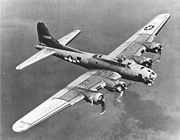
Deicing boot
Encyclopedia


Aircraft
An aircraft is a vehicle that is able to fly by gaining support from the air, or, in general, the atmosphere of a planet. An aircraft counters the force of gravity by using either static lift or by using the dynamic lift of an airfoil, or in a few cases the downward thrust from jet engines.Although...
surfaces to permit a mechanical deicing
Deicing
For snow and ice control on roadways and similar facilities, see Snow removalDe-icing is defined as removal of snow, ice or frost from a surface...
in flight. Such boots are generally installed on the leading edges of wings and control surfaces (e.g. horizontal and vertical stabilizer
Vertical stabilizer
The vertical stabilizers, vertical stabilisers, or fins, of aircraft, missiles or bombs are typically found on the aft end of the fuselage or body, and are intended to reduce aerodynamic side slip. It is analogical to a skeg on boats and ships.On aircraft, vertical stabilizers generally point upwards...
) as these areas are most likely to accumulate ice and any contamination could severely affect the aircraft's performance.
Design
A deicing boot consists of a thick rubber membrane that is installed over the surface. As atmospheric icingAtmospheric icing
Atmospheric icing occurs when water droplets in the atmosphere freeze on objects they contact. This can be extremely dangerous to aircraft, as the built-up ice changes the aerodynamics of the flight surfaces, which can increase the risk of a subsequent stalling of the airfoil...
occurs and ice builds up, a pneumatic system inflates the boot with compressed air. This expansion in size cracks any ice that has accumulated, and this ice is then blown away by the airflow. The boots are then deflated to return the wing or surface to its optimal shape.
They are an older technology and have some drawbacks. Boots need to be replaced frequently (on the order of 2–3 years) and proper care for deicing boots is critical. Any holes in the boot will create air leaks that will decrease, if not eliminate, any effect that the boots may have. As such, boots must be carefully inspected before each flight and any holes or cuts must be patched.
Deicing boots have undoubtedly saved many lives and have permitted flight into known icing conditions, but they are unable to handle extremely severe icing. In these cases, ice can accumulate faster than the boots can shed it, or ice can accumulate on non-booted surfaces to the point where it disrupts airflow enough to cause a dangerous loss of lift or control.
Invention and use
Deicing boots were invented by the B.F. Goodrich CorporationGoodrich Corporation
The Goodrich Corporation , formerly the B.F. Goodrich Company, is an American aerospace manufacturing company based in Charlotte, North Carolina. Founded in Akron, Ohio in 1870 as Goodrich, Tew & Co. by Dr. Benjamin Franklin Goodrich. The company name was changed to the "B.F...
in 1923 in Akron, Ohio
Akron, Ohio
Akron , is the fifth largest city in the U.S. state of Ohio and the county seat of Summit County. It is located in the Great Lakes region approximately south of Lake Erie along the Little Cuyahoga River. As of the 2010 census, the city had a population of 199,110. The Akron Metropolitan...
. Goodrich in its quest to invent and develop icing boots, built one of the largest indoor facilities to replicate bad weather and icing on aircraft wings in Akron.
Deicing boots are most commonly seen on medium-sized airliners and utility aircraft. Larger airliners and military jets tend to use heating systems that are installed underneath the wing's leading edge, keeping it constantly warm and preventing ice from forming.
Alternatives
Other deicing techniques for larger commercial aircraft usually include, but are not limited to, electrothermal systems and bleed airBleed air
Bleed air in gas turbine engines is compressed air taken from within the engine, after the compressor stage and before the fuel is injected in the burners. While in theory bleed air could be drawn in any gas turbine engine, its usage is generally restricted to jet engines used in aircraft...
systems. Electrothermal systems usually require substantial electrical power and are generally limited to large aircraft which can supply this energy through generators. Bleed air systems use hot air from the engine exhaust manifold
Exhaust manifold
In automotive engineering, an exhaust manifold collects the exhaust gases from multiple cylinders into one pipe. The word manifold comes from the Old English word manigfeald and refers to the folding together of multiple inputs and outputs.In contrast, an inlet manifold is the part of an engine...
s which is routed via high-pressure ducting (piccolo ducts) to the leading edge (main) of the wings, and/or horizontal and vertical tail stabilizers.
With Boeing's use of electrothermal ice protection on the wings of the 787 and with Boeing's More Electric Aircraft (or even All Electric Aircraft) initiative, electrothermal ice protection systems are being considered more prominently than boots and bleed air systems on commercial aircraft. General aviation jets also are studying the effect on thrust and fuel consumption of bleed air and additional benefits of its removal.

